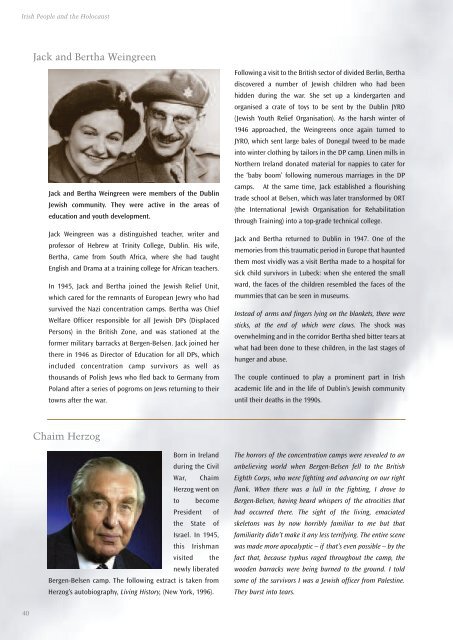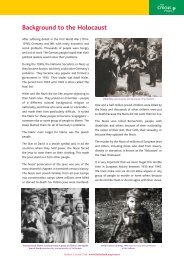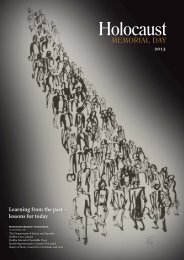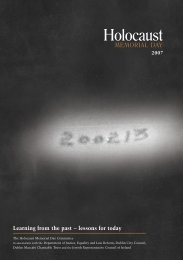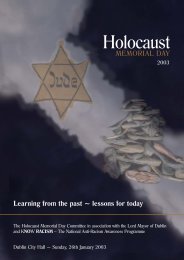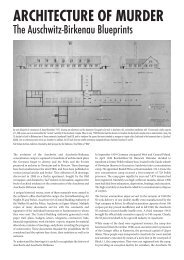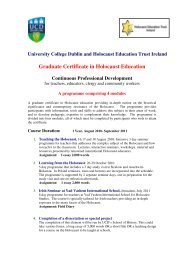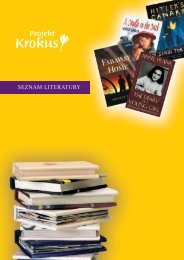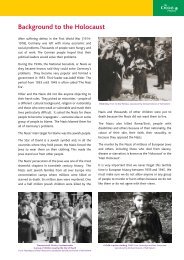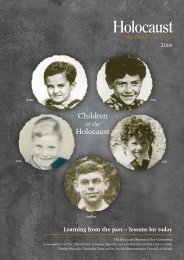Learning from the past ~ lessons for today - Holocaust Education ...
Learning from the past ~ lessons for today - Holocaust Education ...
Learning from the past ~ lessons for today - Holocaust Education ...
You also want an ePaper? Increase the reach of your titles
YUMPU automatically turns print PDFs into web optimized ePapers that Google loves.
Irish People and <strong>the</strong> <strong>Holocaust</strong><br />
Jack and Bertha Weingreen<br />
Jack and Bertha Weingreen were members of <strong>the</strong> Dublin<br />
Jewish community. They were active in <strong>the</strong> areas of<br />
education and youth development.<br />
Jack Weingreen was a distinguished teacher, writer and<br />
professor of Hebrew at Trinity College, Dublin. His wife,<br />
Bertha, came <strong>from</strong> South Africa, where she had taught<br />
English and Drama at a training college <strong>for</strong> African teachers.<br />
In 1945, Jack and Bertha joined <strong>the</strong> Jewish Relief Unit,<br />
which cared <strong>for</strong> <strong>the</strong> remnants of European Jewry who had<br />
survived <strong>the</strong> Nazi concentration camps. Bertha was Chief<br />
Welfare Officer responsible <strong>for</strong> all Jewish DPs (Displaced<br />
Persons) in <strong>the</strong> British Zone, and was stationed at <strong>the</strong><br />
<strong>for</strong>mer military barracks at Bergen-Belsen. Jack joined her<br />
<strong>the</strong>re in 1946 as Director of <strong>Education</strong> <strong>for</strong> all DPs, which<br />
included concentration camp survivors as well as<br />
thousands of Polish Jews who fled back to Germany <strong>from</strong><br />
Poland after a series of pogroms on Jews returning to <strong>the</strong>ir<br />
towns after <strong>the</strong> war.<br />
Following a visit to <strong>the</strong> British sector of divided Berlin, Bertha<br />
discovered a number of Jewish children who had been<br />
hidden during <strong>the</strong> war. She set up a kindergarten and<br />
organised a crate of toys to be sent by <strong>the</strong> Dublin JYRO<br />
(Jewish Youth Relief Organisation). As <strong>the</strong> harsh winter of<br />
1946 approached, <strong>the</strong> Weingreens once again turned to<br />
JYRO, which sent large bales of Donegal tweed to be made<br />
into winter clothing by tailors in <strong>the</strong> DP camp. Linen mills in<br />
Nor<strong>the</strong>rn Ireland donated material <strong>for</strong> nappies to cater <strong>for</strong><br />
<strong>the</strong> ‘baby boom’ following numerous marriages in <strong>the</strong> DP<br />
camps. At <strong>the</strong> same time, Jack established a flourishing<br />
trade school at Belsen, which was later trans<strong>for</strong>med by ORT<br />
(<strong>the</strong> International Jewish Organisation <strong>for</strong> Rehabilitation<br />
through Training) into a top-grade technical college.<br />
Jack and Bertha returned to Dublin in 1947. One of <strong>the</strong><br />
memories <strong>from</strong> this traumatic period in Europe that haunted<br />
<strong>the</strong>m most vividly was a visit Bertha made to a hospital <strong>for</strong><br />
sick child survivors in Lubeck: when she entered <strong>the</strong> small<br />
ward, <strong>the</strong> faces of <strong>the</strong> children resembled <strong>the</strong> faces of <strong>the</strong><br />
mummies that can be seen in museums.<br />
Instead of arms and fingers lying on <strong>the</strong> blankets, <strong>the</strong>re were<br />
sticks, at <strong>the</strong> end of which were claws. The shock was<br />
overwhelming and in <strong>the</strong> corridor Bertha shed bitter tears at<br />
what had been done to <strong>the</strong>se children, in <strong>the</strong> last stages of<br />
hunger and abuse.<br />
The couple continued to play a prominent part in Irish<br />
academic life and in <strong>the</strong> life of Dublin’s Jewish community<br />
until <strong>the</strong>ir deaths in <strong>the</strong> 1990s.<br />
Chaim Herzog<br />
Born in Ireland<br />
during <strong>the</strong> Civil<br />
War, Chaim<br />
Herzog went on<br />
to become<br />
President of<br />
<strong>the</strong> State of<br />
Israel. In 1945,<br />
this Irishman<br />
visited <strong>the</strong><br />
newly liberated<br />
Bergen-Belsen camp. The following extract is taken <strong>from</strong><br />
Herzog’s autobiography, Living History, (New York, 1996).<br />
The horrors of <strong>the</strong> concentration camps were revealed to an<br />
unbelieving world when Bergen-Belsen fell to <strong>the</strong> British<br />
Eighth Corps, who were fighting and advancing on our right<br />
flank. When <strong>the</strong>re was a lull in <strong>the</strong> fighting, I drove to<br />
Bergen-Belsen, having heard whispers of <strong>the</strong> atrocities that<br />
had occurred <strong>the</strong>re. The sight of <strong>the</strong> living, emaciated<br />
skeletons was by now horribly familiar to me but that<br />
familiarity didn’t make it any less terrifying. The entire scene<br />
was made more apocalyptic – if that’s even possible – by <strong>the</strong><br />
fact that, because typhus raged throughout <strong>the</strong> camp, <strong>the</strong><br />
wooden barracks were being burned to <strong>the</strong> ground. I told<br />
some of <strong>the</strong> survivors I was a Jewish officer <strong>from</strong> Palestine.<br />
They burst into tears.<br />
40


